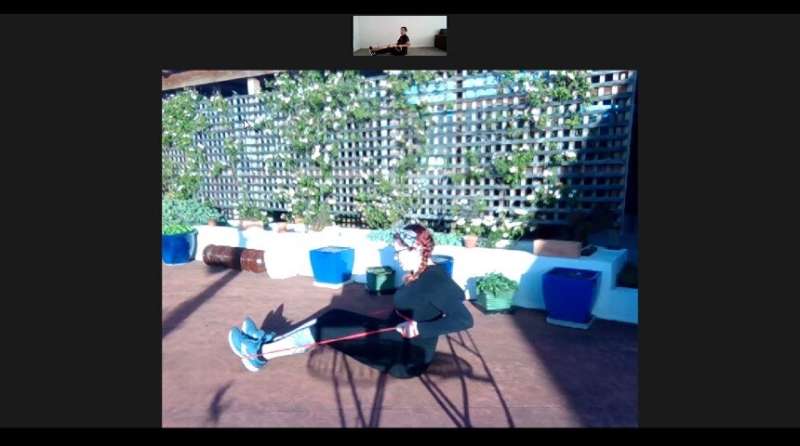Patients with multiple sclerosis taking part in rehabilitation sessions held via video conference. Credit: Murdoch University
Students and researchers from Murdoch are investigating ways improve the telehealth services and programs delivered to the multiple sclerosis community to increase participation rates.
For people living with multiple sclerosis (MS), exercise can help manage many of their symptoms and improve their general health. While these benefits are widely known, participation in regular physical activity is still a challenge for many.
Dr. Yvonne Learmonth, Senior Lecturer in Exercise Science at Murdoch University, is working with her students and colleagues to investigate ways of increasing the number of Australians with MS participating in exercise programs.
The first phase of the study focused on interviewing people with MS, carers and healthcare providers to better understand their views on the accessibility and suitability of exercise programs for rural Australians with MS.
"One example of this is our Project GEMS+ study, which trials a telehealth home-based exercise program using MS physical exercise guidelines and theories of behavior change to help people understand why exercise is good for them. And, more importantly, stick to it."
The first phase included a randomized control trial with 72 people with mild to moderate MS symptoms—meaning that they were all able to walk independently or with the use of a walking stick.
"One group are continuing their usual exercise behaviors, while the other group received the exercise program. This included equipment like a pedometer, elastic resistance bands, as well as access to an online exercise program, video coaching calls and educational newsletters to assist with the exercises from home," explained Dr. Learmonth.
"We asked them to fill out questionnaires designed to rate and measure their current participation in exercise, and perceived mobility and strength, feelings of fatigue, mood and overall attitude towards exercise before, during and after the trial period."
The benefits of a telehealth service
Dr. Learnmonth said delivering the progream through a telehealth service meant it could be distributed to a wide population.
"The interest has been overwhelmingly positive nationwide. We have recruited locals living in Perth to participants in the eastern states," she said.
"The telehealth approach proved to be a real benefit in reaching remote communities or cities where they might not have access to exercise physiologists or physiotherapists. It's also important to remember people in big cities might not have easy access to these resources as well. It might be difficult for them to commute to a clinic or they become reliant on a health professional's equipment and external motivation, so they don't continue on their own."
Shaping the future of clinical practice
The results from Project GEMS+ has already shown high interest in the study, with over 700 people accessing information about the study online.
Dr. Learmonth said the first wave of Project GEMS+ participants have demonstrated moderate increases in self-reported exercise behavior, and overall compliance with the program among the group that received the intervention strategies.
The study is now observing its second wave of MS patients, using the results to refine the program and its delivery. The team are now preparing the project for adoption by Australian health professionals to trial Project GEMS+ as part of regular clinical practice.
"At the end of the day, we want to increase access to exercise treatment for all people with MS by removing the physical and psychological barriers currently in place," said Dr. Learmonth.
"We hope to empower them to take ownership of their own health with the guidance of healthcare professionals, and our results show we're getting closer to that goal."
Provided by Murdoch University






















